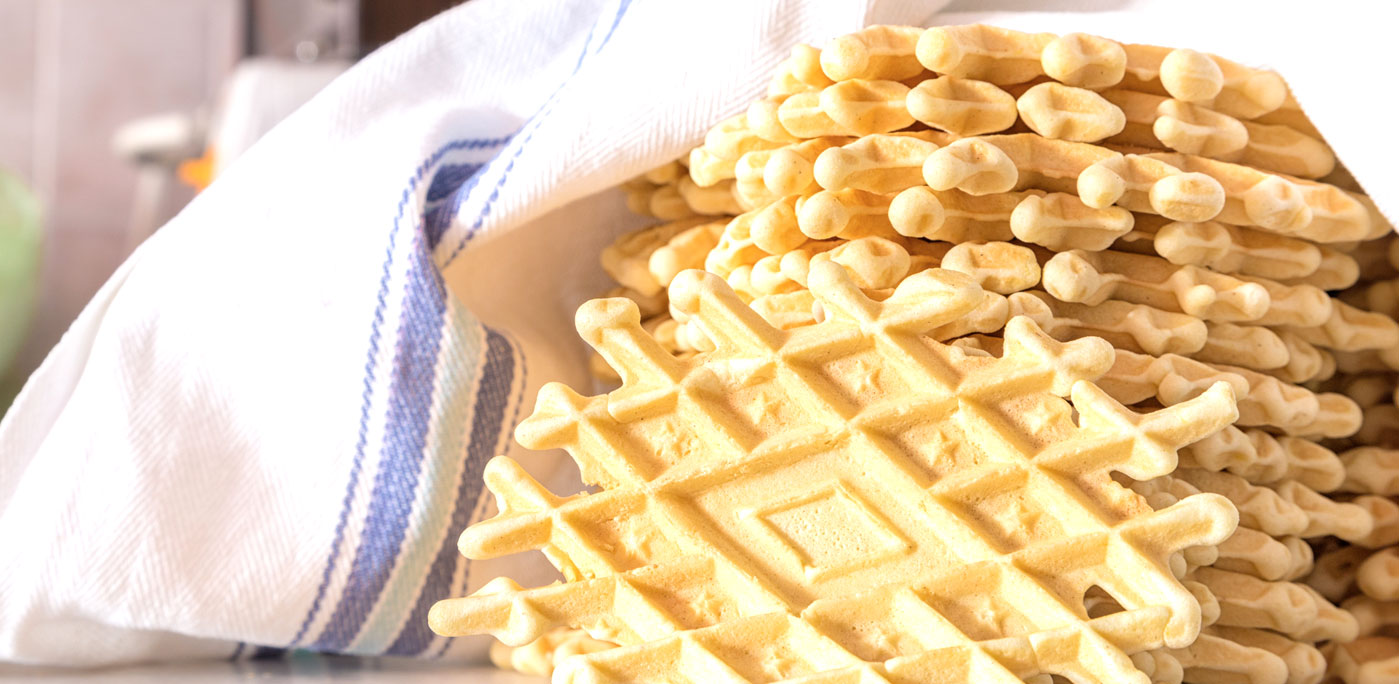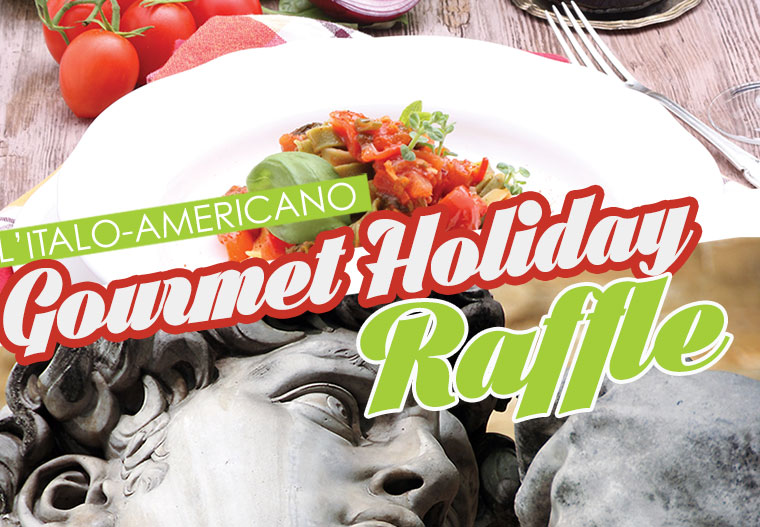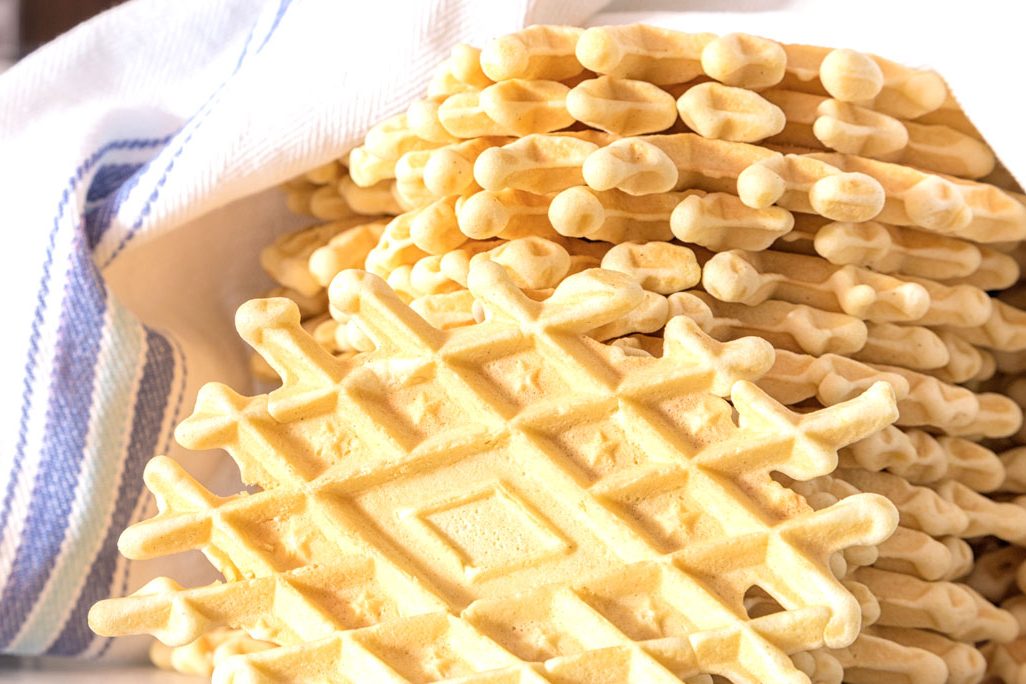Christmas is on its way, and it’s time for pizzelle – “little pizzas.” Italy’s crisp waffle cookies have many regional names, nevole, ciarancelle and catarrette among them. In Abruzzo, where the cookie is believed to have originated, they are known as ferratelle, after lu ferro, the iron tool used to bake the cookies.
Originally lu ferro was made of two rectangular plates, each on a long locking handle. The handles were long enough to afford protection to the cook’s hands as the iron was held over an open fire. The inside of the plates, the side on which the cookies are baked, was etched with a grate-like design, perhaps inspired by the screens in nunneries where the cookies were sold. In fact, another name for these cookies is cancellette.
Traditionally the cookies are formed by rolling a piece of dough into a rope and then forming a figure eight. It is then placed on one of the plates. The long handles are locked and the plates held over an open fire to bake. In years gone by it was customary for a family to have its own iron, often a treasured wedding gift, with initials, names or a family insignia etched into one of the inside plates. After many years of use these irons took on a beautiful patina and held a wealth of family memories.
Today irons are marketed in the U.S. as pizzelle makers. Most produce round cookies, but irons that make square and rectangular cookies are also available. All have designs etched into the cooking surfaces, some quite elaborate, mimicking 3-D artwork. Electric units look like small waffle irons. Aluminum irons for stovetop and hearth use are designed very much like the irons of old. They are widely available at cookware stores and at Amazon.com. Antique stores and eBay are wonderful sources for vintage irons. And be sure to check your nonna’s attic – you just might find a treasure.
No matter what you call these cookies and no matter your region, all recipes have four ingredients in common – flour, sugar, eggs, and some kind of fat. They are often flavored with anise, either ground seeds, oil or extract, but name a flavoring and someone uses it. Citrus adds fresh flavor while cinnamon imparts warmth. Chocolate and almond are particular favorites. Try Fiori di Sicilia – its orange, vanilla and jasmine notes impart delightful flavor and the cookies will perfume your kitchen as they bake.
Experiment with browning the butter for additional depth of flavor. Pizzelle are typically served flat, but can be molded into tubes or cones while hot. The cooled tubes and cones are delicious filled with whipped cream, chocolate or Nutella.
Electric units assure standardized cooking time and even browning and are simple to use – no more complicated than your Sunday waffles. Cooking time at the stovetop or hearth will vary, but look to an age old method: say an Ave Maria while you cook the first side, flip the iron and finish with a Pater Noster. Ah, tradition!
Pizzelle
makes about 30
1 3/4 cup 00 or all-purpose flour
1 stick (8 tablespoons) unsalted butter, melted and cooled
½ cup granulated sugar
2 large eggs plus 1 large egg yolk
1 ½ teaspoons vanilla extract
1/4 to ½ teaspoon anise oil
1 teaspoon baking powder
pinch kosher salt
This recipe produces a malleable dough. Directions are for an electric unit that produces 4 ½ inch round cookies. Baking time and cookie size may vary from unit to unit.
Place a towel beneath the iron to catch leaks. Heat iron.
Melt butter. Set aside.
Combine flour, baking powder and salt in a small bowl. Set aside.
Beat eggs, egg yolk and sugar until light in color in medium bowl.
Add melted butter, vanilla and anise oil (or other flavorings/zest) and stir to incorporate.
Gently add flour mixture in three additions. Dough will form a ball.
Use a tablespoon size scoop to form dough into 30 balls. Place 1 ball of dough on each cooking plate and lock lid.
Bake until steam no longer escapes, about 40 seconds. Cool on rack. Store in airtight container.
If cookies lose their crispness, reheat in a 350 degree F. oven for just a few minutes to dry.
Variations:
Fiori di Sicilia pizzelle:
Decrease vanilla to 1 teaspoon. Omit anise oil. Add 1 teaspoon Fiori di Sicilia along with the melted butter and vanilla. Proceed as directed.
Almond pizzelle:
Toast ½ cup slivered almonds at 325 degrees F. until fragrant, about 8 minutes. Cool and chop finely. Add to flour. Decrease vanilla to ½ teaspoon. Add 1 tablespoon Amaretto and ½ teaspoon almond extract. Omit anise oil. Proceed as directed.
Chocolate pizzelle:
Decrease flour by 1/4 cup and replace with 1/4 cup unsweetened cocoa. Increase sugar to 2/3 cup. Omit anise oil. Proceed as directed.
Cook’s Notes: Fiori di Sicilia is available from KingArthurFlour.com. 00 flour, a finely milled Italian wheat flour available at many Italian markets and Amazon.com, produces a light cookie.
Questions? Email me at adri@AdriBarrCrocetti.com or visit my site at AdriBarrCrocetti.com and search on “ferratelle” for a step by step photo essay.
































